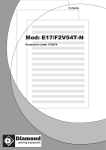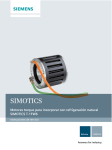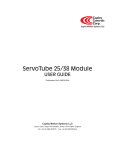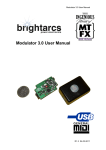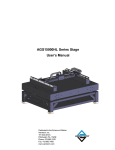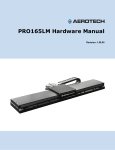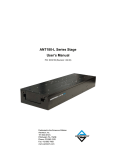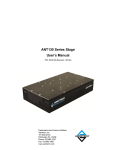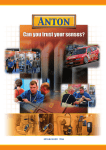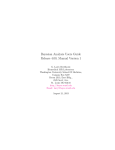Download Flat Linear Motor Hardware Manual
Transcript
Flat Linear Motor Hardware Manual P/N: EDA138 (Revision: 2.00.00) Dedicated to the Science of Motion Aerotech, Inc. 101 Zeta Drive, Pittsburgh, PA, 15238 Phone: 412-963-7470 Fax: 412-963-7459 www.aerotech.com Product Registration Register online at: http://www.aerotech.com/prodreg.cfm Technical Support United States: Phone: (412) 967-6440 Fax: (412) 967-6870 Email: [email protected] United Kingdom: Phone: +44 118 9409400 Fax: +44 118 9409401 Email: [email protected] Germany: Phone: +49 911 9679370 Fax: +49 911 96793720 Email: [email protected] Japan: Phone: Phone: Fax: Email: Revision History +81(0)47-489-1741 (Sales) +81(0)47-489-1742 (Service) +81(0)47-489-1743 [email protected] 2.00.00 1.02 1.01 1.00 October 29, 2007 September 2, 2001 September 20, 2000 September 28, 1997 Product names mentioned herein are used for identification purposes only and may be trademarks of their respective companies. © Aerotech, Inc. 2007 Flat Linear Motor Hardware Manual Table of Contents TABLE OF CONTENTS ELECTRICAL SAFETY INFORMATION ....................................... ix CHAPTER 1: 1.1. 1.2. 1.3. 1.4. 1.5. 1.6. 1.7. 1.8. 1.9. 1.10. 1.11. INTRODUCTION ................................................ 1-1 Product Overview......................................................................1-1 Safety Information .....................................................................1-2 Motor Assembly and Installation ...............................................1-4 1.3.1. Bearing System............................................................1-5 1.3.2. Straightness and Flatness Requirements....................1-5 1.3.3. Mechanical Arrangement of the Magnet Track............1-5 1.3.4. Track Stacking .............................................................1-6 1.3.5. Position Transducer Resolution...................................1-6 1.3.6. Cable Management......................................................1-6 Motor Wiring..............................................................................1-7 1.4.1. Motor Power Conductors .............................................1-8 1.4.2. Protective Ground ........................................................1-8 1.4.3. Over Current Protection ...............................................1-8 1.4.4. Hall Effect Device and Thermistor Wiring ....................1-9 1.4.5. Wiring Guidelines.........................................................1-9 1.4.6. Thermal Protective Device...........................................1-9 Hall Effect Operation and Motor Phasing ...............................1-11 Motor Heating..........................................................................1-12 Maintenance............................................................................1-13 Environmental Specifications..................................................1-14 Motor Specifications................................................................1-15 Brushless Motor Dimensions ..................................................1-18 Part Number and Ordering Information ..................................1-20 APPENDIX A: GLOSSARY OF TERMS ................................... A-1 APPENDIX B: WARRANTY AND FIELD SERVICE ................. B-1 APPENDIX C: TECHNICAL CHANGES ................................... C-1 C.1. C.2. Current Changes (Revision: 2.00.00) ...................................... C-1 Archived Changes.................................................................... C-2 INDEX ......................................................................................... D-1 READER’S COMMENTS .............................................................E-1 ∇ ∇ ∇ www.aerotech.com iii Table of Contents iv Flat Linear Motor Hardware Manual www.aerotech.com Flat Linear Motor Hardware Manual List of Figures LIST OF FIGURES Figure 1-1: Figure 1-2: Figure 1-3: Figure 1-4: Figure 1-5: Figure 1-6: Figure 1-7: Figure 1-8: Figure 1-9: Figure 1-10: Figure 1-11: Flat Linear Motors .....................................................................1-1 BLMF Straightness and Flatness Tolerances...........................1-5 Stacking Tracks ........................................................................1-6 Linear Motor with Tape Scale Encoder and Cable Management .............................................................................1-6 Wiring Overview ........................................................................1-7 Typical Amplifier Wiring ............................................................1-8 Thermal Sensor Resistance as a Function of Temperature, φNAT = Response Temperature ........................1-10 Typical Thermistor Interface Circuit ........................................1-10 Linear Motor Phasing..............................................................1-11 BLMF Model Dimensions........................................................1-18 BLMFS5 Model Dimensions ...................................................1-19 ∇ ∇ ∇ www.aerotech.com v List of Figures vi Flat Linear Motor Hardware Manual www.aerotech.com Flat Linear Motor Hardware Manual List of Tables LIST OF TABLES Table 1-1: Table 1-2: Table 1-3: Table 1-4: Table 1-5: Table 1-6: Table 1-7: Table 1-8: Table 1-9: BLMFI (“Ironless”) Series Linear Motor Specifications ...........1-15 BLMFS (Steel Laminated) Series Linear Motor Specifications ..........................................................................1-16 BLMFS5 (Steel Laminated) Series Linear Motor Specifications ..........................................................................1-17 BLMFI Motor Part Number and Ordering Example ................1-20 BLMFI Motor Options..............................................................1-20 BLMFS Motor Part Number and Ordering Example ...............1-21 BLMFS Motor Options ............................................................1-21 BLMFS5 Motor Part Number and Ordering Example .............1-22 BLMFS5 Motor Options ..........................................................1-22 ∇ ∇ ∇ www.aerotech.com vii List of Tables viii Flat Linear Motor Hardware Manual www.aerotech.com Flat Linear Motor Hardware Manual Electrical Safety Information ELECTRICAL SAFETY INFORMATION Manufacturer’s Name and Address: Aerotech, Inc. 101 Zeta Drive Pittsburgh, PA 15238-2897 Intended Use: This product is intended for light industrial manufacturing or laboratory use. Safety Information: • All BLMFI-XXX motors pass hi-pot tests per IEC 61010 using test voltages of 2880VAC and 4080VDC. • All BLMFS-XXX motors pass hi-pot tests per IEC 61010 using test voltages of 1830VAC and 2590VDC. • User must restrict user access to motor coil / wires while energized. This is accomplished by providing an enclosure around the operating components which, when opened, removes power to the drive. The motor may also be contained in a grounded mechanical system (positioning stage) which restricts direct access to the high voltage motor components. • The drive electronics must monitor current and servo position error. See user manual for RMS current level settings. Position error detection is application dependent and should be set to the minimum value allowed by the application. • The motor over temperature sensor must be monitored by the drive and used to shut down the drive in the even of excessive motor temperatures. • Motor frame is safety grounded with a conduct equal in size to the phase conductors. • The drive must contain a properly sized fuse, matched to the motor cable wire size. David F. Kincel Quality Assurance Manager Pittsburgh, PA December 2006 Alex Weibel www.aerotech.com Engineer Verifying Compliance ix Electrical Safety Information Flat Linear Motor Hardware Manual ∇ ∇ ∇ x www.aerotech.com Flat Linear Motor Hardware Manual CHAPTER 1: 1.1. Introduction INTRODUCTION Product Overview The BLMF flat linear motor is a unique transmission system that provides extremely fast response with speeds up to 400in/sec (10m/sec) and exceptional positioning accuracy. Resolution and accuracy of the motors are limited only by the user’s position transducer, bearing, and servo control. The motor construction consists of a forcer and a rare earth magnet track that eliminates backlash, windup, and wear most commonly associated with ball screws, belts, or racks. Flat linear motors can be incorporated into gantry systems or positioning stages with mechanical or air bearings, and they are well suited for both general purpose positioning and ultra precision applications such as: • • • • • • PC Board Insertion Machinery Pick and Place Robots Laser Marking X-ray and E-beam Lithography Semiconductor Laser Direct Writing Precision Diamond Cutting Figure 1-1: Flat Linear Motors Flat linear motors consist of one forcer and one or more magnet tracks. • The BLMFI models consist of a flat forcer that is a non-magnetic epoxy based design. These models are best suited for applications where cogging forces cannot be tolerated. • The BLMFS models consist of a flat forcer that is epoxy based with steel laminations. This design is best suited for applications where increased force is required and the magnetic attractive force between the forcer and the track can be tolerated. • The BLMFS5 models are an epoxy encapsulated steel core forcer. This design is best suited for applications which provide high force per unit volume and where increased cogging and magnetic attractive forces between the forcer and the track can be tolerated. www.aerotech.com 1-1 Introduction Flat Linear Motor Hardware Manual 1.2. Safety Information NOTE Read this manual in its entirety before installing, operating, or servicing this product. If you do not understand the information contained here contact an Aerotech representative before proceeding. Strictly adhere to the statements given in this section and other handling, use, and operational information given throughout the manual to avoid injury to you and damage to the equipment. WARNING Aerotech’s Flat Linear Motors are meant to be part of a drive package consisting of an amplifier and controller. The motor relies on the drive package for all manners of fault protection. Aerotech, Inc does not approve their motors for use in any other manner. WARNING To prevent electrical shock hazards only allow qualified persons to install and service this equipment. Equipment grounds must be in place and maintained to reduce the risk of potentially fatal or serious injury from electrical shock. Never install or operate equipment that appears to be damaged. WARNING DANGER Use extreme caution when handling the magnet track. The magnet track will clamp to any ferrous surface with extreme force. If you are unsure of the proper methods of handling or installing the magnet track do not attempt to do so. DANGER Use extreme caution when mounting the BLMFS & BLMFS5 forcer above the track. The forcer will clamp to the track with extreme force if allowed to do so. Fixtures need to be in place to prevent this from occurring. WARNING Disconnect electrical power to the motor before performing maintenance procedures. In addition, uncouple or otherwise prevent motor-coupled machinery from moving the motor during servicing. WARNING 1-2 Linear motors are capable of very high speeds and acceleration rates. Always avoid being in the direct path of moving machinery. www.aerotech.com Flat Linear Motor Hardware Manual Introduction The motor case temperature can pose a burn hazard. Do not touch the motor until it has cooled sufficiently. HOT DANGER These motors are not rated for use in explosive atmospheres. They are not to be operated in the presence of potentially explosive mixtures of air-borne dust or combustible vapors. WARNING Motors and their associated drives, cabling, etc. are sources of electromagnetic fields. Persons with external or implanted medical devices need to evaluate the risks associated with these devices before entering an area where they are in use. www.aerotech.com 1-3 Introduction Flat Linear Motor Hardware Manual 1.3. Motor Assembly and Installation The linear motor can be configured in two different ways. The magnet track can be held stationary while the forcer moves or the forcer can be held stationary while the magnet track moves. DANGER WARNING Use extreme caution when mounting the BLMFS & BLMFS5 forcer. The forcer will clamp to the track with extreme force if allowed to do so. Attach the forcer rigidly in its’ mounting position working away from the track not above it. The forcer and track have to be rigidly mounted before allowing the forcer to move into position over the track. Devices need to be in place so that intentional or unintentional disruption of electrical power doesn’t result in unexpected motion. The motion could possibly result in bodily injury or damage to equipment. This is especially important in vertical applications where the use of a failsafe brake needs to be incorporated in the event of a power disruption. Listed below are some installation topics of special concern that need to be addressed when installing a linear motor: 1-4 • Bearing System • Straightness and Flatness Requirements of the Motor Installation • Mechanical Arrangement of the Magnet Track • Track Stacking • Position Feedback Device Requirements • Thermal Management of the Motion System • Cable Management Needs www.aerotech.com Flat Linear Motor Hardware Manual Introduction 1.3.1. Bearing System The flat linear motor arrangement and load must be supported by a linear bearing system. The bearing system must be capable of supporting the forcer, the load, and, in the case of using BLMFS and BLMFS5 forcers, a considerable magnetic attractive force between the forcer and the magnet track. 1.3.2. Straightness and Flatness Requirements Straightness and flatness tolerances are deviations from a straight line in two dimensions. There are two separate alignment tolerances: straightness (side-to-side), and flatness (air gap) of the motor, that need to be maintained over the length of travel. Mounting surface flatness has to be held to specific tolerances to maintain desirable motor performance. Straightness The forcer may deviate left or right ±0.030 in (±0.76 mm) from the magnet track centerline during motion, see Figure 1-2. Generally the BLMF motor operates regardless of straightness provided the forcer does not contact the magnet track during motion. Flatness The nominal air gap between the forcer and magnet track surfaces is 0.030 in (0.76 mm) for the BLMFS5 forcer and 0.050 in (1.27 mm) for the BLMFI and BLMFS forcers. The air gap has a tolerance specification of +0.010 in / -0.000 in (+0.25 mm / -0.00 mm). Larger gaps result in a decrease of output force from the motor. Smaller gaps result in a significantly increased magnetic attractive force of the forcer to the track. Center Line Flatness Magnet Gap BLMFS5: 0.030 in (0.76 mm) Nominal BLMFI: 0.050 in (1.27 mm) Nominal BLMFS: 0.050 in (1.27 mm) Nominal Maximum Deviation: +0.010 in (0.25 mm) -0.000 in (0.00 mm) Straightness Magnet Gap Maximum Deviation: ±0.030 in (0.76 mm) Nominal Figure 1-2: BLMF Straightness and Flatness Tolerances 1.3.3. Mechanical Arrangement of the Magnet Track The track can be mounted in a horizontal or vertical orientation. In addition, the track can be the stationary or moving part of the machine. With the forcer stationary and the magnet track moving, the load generally increases, but the cable management system is simplified. A stationary forcer usually allows for increased heat transfer from the forcer. www.aerotech.com 1-5 Introduction Flat Linear Motor Hardware Manual 1.3.4. Track Stacking To increase the linear motor travel distance, magnet tracks can be stacked end-to-end as shown in Figure 1-3. Magnet Track 2 Magnet Track 1 Figure 1-3: Stacking Tracks 1.3.5. Position Transducer Resolution The motion controller requires the use of a position transducer for all forms of motion control. This is typically a linear encoder. The specific application determines the encoder resolution. 1.3.6. Cable Management A high-flex cable management system must be used to connect the forcer and feedback signals to the stationary motion controller. The cable that exits the BLMF forcer is not a high-flex type, therefore it must terminate before entering the cable management system, see Figure 1-4. Termination of the forcer and encoder cable is in most cases through a Dshell connector. A mating D-shell connector serves as the termination point of the highflex cable in the cable management track. Bearing Detail showing Linear Encoder Scale Linear Motor Stage Tabletop Bearing System Cable Management System (CMS) Figure 1-4: 1-6 Hardcover Removed Linear Motor with Tape Scale Encoder and Cable Management www.aerotech.com Flat Linear Motor Hardware Manual 1.4. Introduction Motor Wiring The forcer is supplied with flying leads for the motor winding, Hall effect devices, and thermal overload sensor. The customer supplies all external wiring to interface with these devices. This supplied wiring must meet certain requirements to provide for safe and reliable operation. The wiring must be able to supply the rated current without overheating. The wire insulation must be rated for the voltage and temperature at which the motor is operating. And, efforts must also be made to reduce EMI emissions and to increase EMI immunity through proper cable selection and installation. In addition to supplying the external wiring the customer is also responsible for providing over current protection for the motor. Guidelines are given below to help with the selection and installation of the wiring. Feedback Connector +5V Signal Common Thermistor + Thermistor Hall A Hall B Hall C (red) (black) (black/white) (red/black) (blue) (white) (orange) Motor Connector Phase A Phase B Phase C Neutral Frame Ground Independent Phase Controller Phase A (+) black (-) blue Phase B (+) red Phase C (+) white (-) yellow Neutral (-) brown none * Frame Ground green * see Figure 1-4 for more information Figure 1-5: www.aerotech.com Wiring Overview 1-7 Introduction Flat Linear Motor Hardware Manual Phase A Phase B black red blue brown yellow Blue, Brown, and Yellow electrically tied to form neutral. Wye Connection (typical) white Figure 1-6: Phase C Typical Amplifier Wiring 1.4.1. Motor Power Conductors The motor power conductors must be sized to handle the electrical current requirements of the motor. The motor data sheets list the required values for the various motors. The wire insulation voltage rating is chosen based on the maximum voltage that will be applied to the motor. 1.4.2. Protective Ground The protective ground is a safety conductor used to ground the motor case. The protective ground conductor must have a current carrying capacity at least equal to that of the motor wires. The insulation is standard Green/Yellow and must be rated for the maximum voltage applied to the motor winding. The protective ground wire is usually bundled along with the motor wires, but system requirements may be that a separate protective ground wire is needed. 1.4.3. Over Current Protection Motors need to be provided with over current protection to prevent motor overheating. Over current protection can be accomplished using programmable current limits, traps, over current protection circuitry, or fusing. Fuse values should be selected according to the RMS current rating of the motor. For most applications slow-blow type fuses should be used. When the motor is part of an Aerotech system utilizing an Aerotech controller and drive, the “Amppk” continuous current rating of the motor must be used to set the motor overcurrent protection fault. If the motor is being installed in a system not configured by Aerotech the customer is responsible for providing the necessary over current protection. 1-8 www.aerotech.com Flat Linear Motor Hardware Manual Introduction 1.4.4. Hall Effect Device and Thermistor Wiring The insulation of these wires should have a rating for at least the maximum voltage applied to the motor winding. The temperature rating of the wire insulation must also be sufficiently high to withstand the operating temperatures specific to the application. 1.4.5. Wiring Guidelines The wiring guidelines given below can help to reduce EMI related problems which can result in poor overall system performance. • Keep cable lengths as short as possible. Long cable runs are more susceptible to EMI pickup than short runs. • Use grounded shielded cables for both the motor power and signal wiring • The use of twisted pair shielded cabling can help reduce magnetically induced currents. • Braided shield has a slightly better low frequency shielding capability than a foil shield. Foil is often used where RF shielding is necessary. • Do not bundle signal, motor power cables, or ac power lines within the same protective shield or conduit. Rather use separate protective shields or conduits. • Do not introduce multiple paths to ground from a grounding point. Multiple paths to ground can create ground loops within the system. • The use of EMI suppression devices may be necessary where the EMI environment warrants their use. 1.4.6. Thermal Protective Device The motor’s thermal protection device is a positive temperature coefficient thermistor. This device exhibits a rapid increase in resistance as the motor temperature approaches the device’s transition temperature, see Figure 1-7. The nominal resistance is 100 ohms at 25°C. At the set point the nominal resistance increases rapidly to 1,000 ohms. This thermistor can be used in a variety of different electronic interfaces. A precaution when using this type of device in an interface circuit is to avoid self-heating effects. An excessive amount of current through the thermistor will cause its temperature to rise. False triggering will then occur. See Figure 1-8 for a typical interface circuit. www.aerotech.com 1-9 Introduction Flat Linear Motor Hardware Manual Rϑ=f(ϑ) 100k Ω Rϑ 2 10k 6 4000Ω 4 2 1330Ω 1k 550Ω 6 4 250Ω 2 100 Figure 1-7: -10 0 10 ϑNAT +15 2 10 -20 ϑNAT +5 4 ϑNAT -5 ϑNAT -20 6 °C Thermal Sensor Resistance as a Function of Temperature, φNAT = Response Temperature +5V 5V Logic Interface 1KΩ Thermal Sensor Figure 1-8: 1-10 0.1µF Typical Thermistor Interface Circuit www.aerotech.com Flat Linear Motor Hardware Manual 1.5. Introduction Hall Effect Operation and Motor Phasing In linear servomotors, one popular method of commutation is with Hall effect sensors. They sense the presence of a magnetic field and provide an output as a function of the forcer position. Aerotech linear motor Hall sensors provide a unique set of Hall sensor outputs every sixty electrical degrees. The forcer position can be resolved to any of six segments over 360 electrical degrees. The Hall sensors used in the linear motors have an open collector output. Figure 1-9 shows the motor BEMF versus hall signal relationship if observed as noted in the figure. Cables Test Setup Configuation POSITIVE MOTION Forcer TP2 Magnet Track B TP3 TP4 Power Supply 0° 1 60° Brushless Motor TP1 2 120° 3 180° 4 240° 5 A 10K OHM TYP "Wye" Configuration COM COM +5V +5V 300° 360° 6 C 10K OHM TYP Hall B +5V 0V Hall C TP5 Hall 1 TP6 Hall 2 TP7 Hall 3 Hall A ØA ØC ØB ØA ØC +V Motor Back EMF 0V -V Positive (+ or CW) Motor Rotation Oscilloscope All voltage measurements are made with reference to TP4. Plus forcer motion is motion in a direction opposite the forcer wire exit end. On a six lead forcer, connect the blue, brown, and yellow wires together. Figure 1-9: www.aerotech.com Channel 1 Probe Channel 2 Probe Probe Common Probe Common (Connect to TP4) (Connect to TP4) Linear Motor Phasing 1-11 Introduction Flat Linear Motor Hardware Manual 1.6. Motor Heating The motor’s temperature rise above ambient establishes a limit on the amount of force producing current allowed through the motor winding. The thermal characteristics of the motor, the effectiveness of the surrounding medium to transfer heat away from the motor, and any supplemental cooling determine the operating conditions. The motor specification tables give the continuous motor current that will result in a predetermined temperature rise of the motor. This temperature rise is based on a single set of operating conditions as noted on the motor specifications. The use of supplemental cooling allows for increases in continuous motor current and therefore increased force. The motor’s thermal limit will not be exceeded so long as the minimum environmental and thermal conditions exist. Poor heat transfer away from the motor, excessive loading, elevated ambient temperatures, etc. are situations that will cause excessive motor heating and failure. The importance of motor overload and thermal protection devices as described in previous sections becomes apparent. 1-12 www.aerotech.com Flat Linear Motor Hardware Manual 1.7. Introduction Maintenance Installation problems usually reveal themselves early in the installation. Regular preventative maintenance should include but is not limited to the following: make frequent checks for excessive or abnormal motor heating, excessive motor vibrations, loose motor to machine couplers, obstructed air flow to the motor, burning smells, an accumulation of debris on the motor, etc. Motors should be wiped with a clean dry cloth to remove any grease, dirt, or other material that has accumulated on the motor. Fluids and sprays are not recommended for chance of internal motor contamination. Cleaning the motor labels should be avoided to prevent their removal. Non-ferrous tools should be used when working around the magnet track. www.aerotech.com 1-13 Introduction Flat Linear Motor Hardware Manual 1.8. Environmental Specifications The environmental considerations for motor operation are given below. Deviating from these specifications may lead to motor failure or an unsafe operating condition. Contact Aerotech for information concerning motor operations under conditions deviating from these environmental specifications. Temperature: Operating: 0° to 25°C, consult Aerotech for performance deration for elevated ambient temperatures Storage: -20°C to 85°C Humidity: Altitude Use Atmosphere 1-14 Ambient conditions need to be such that condensation on the motor does not occur. The motors are not to be used in wash-down environments. Up to 1000 m. Consult Aerotech for deration considerations for altitudes above 1000 m Indoor use only. Not to be used in hydrogen atmospheres www.aerotech.com Flat Linear Motor Hardware Manual 1.9. Introduction Motor Specifications The specifications for the BLMF series brushless motors are listed in Table 1-1, Table 12 and Table 1-3. Table 1-1: BLMFI (“Ironless”) Series Linear Motor Specifications Motor Model Units Performance Specifications (1) (5) Continuous Force, N (lb) No Air (2) Peak Force (3) N (lb) Attraction Force N (lb) Electrical Specifications(5) Winding Designation BEMF Constant V/m/s (V/in/s) (line-line, max) 7.16 3.58 13.81 6.90 14.32 28.63 18.51 37.02 23.01 46.02 (0.18) (0.09) (0.35) (0.18) (0.36) (0.73) (0.47) (0.94) (0.58) (1.17) Continuous Current, (2) No Air Amppk (Amprms) 3.0 6.00 2.70 5.40 5.20 2.60 5.60 2.80 5.60 2.80 (2.12) (4.24) (1.91) (3.82) (3.68) (1.84) (3.96) (1.98) (3.96) (1.98) Peak Current, Stall (3) Amppk (Amprms) 12.00 24.00 10.80 21.60 20.80 10.40 22.40 11.20 22.40 11.20 (8.49) (16.97) (7.64) (15.27) (14.71) (7.35) (15.84) (7.92) (15.84) (7.92) Force Constant, Sine Drive (4) (8) Motor Constant (2) (4) N/Amppk (lb/Amppk) N/Amprms (lb/Amprms) N/√W (lb/√W) Resistance, Ohms 25°C (line-line) Inductance mH (line-line) Thermal Resistance, °C/W No Cooling Maximum Bus Voltage VDC Mechanical Specifications Coil Weight kg (lb) Coil Length mm (in) Heat Sink Magnet Track Weight Magnetic Pole Pitch mm (in) kg/m (lb/ft) mm (in) BLMFS-81 BLMFS-142 BLMFS-264 BLMFS-325 BLMFS-386 18.7 (4.2) 32.4 (7.3) 64.8 (14.6) 90.2 (20.3) 112.1 (25.2) 74.7 (16.8) 0 129.7 (29.2) 0 259.1 (58.2) 0 360.7 (81.1) 0 448.4 (100.8) 0 -A -B -A -B 6.23 3.11 12.01 6.00 (1.40) (0.70) (2.70) (1.35) 8.81 4.40 16.98 8.49 (1.98) (0.99) (3.82) (1.91) 2.59 (0.58) 3.55 (0.80) -A -B 12.45 (2.80) 17.61 (3.96) 24.91 (5.60) 35.23 (7.92) -A -B 16.10 (3.62) 22.77 (5.12) 32.20 (7.24) 45.54 (10.24) -A -B 20.02 (4.50) 28.31 (6.36) 40.03 (9.00) 56.61 (12.73) 5.28 (1.19) 6.16 (1.39) 6.91 (1.55) 5.5 1.4 10.9 2.7 5.3 21.2 6.5 26.0 8.0 32.0 2.90 0.73 6.50 1.63 3.50 14.00 4.48 17.92 5.30 21.20 1.92 1.20 0.66 0.47 0.38 1.40 (3.08) 325.1 (12.80) 150x100x13 (14x14x0.5) 1.70 (3.74) 386.1 (15.20) 400x400x13 (16x16x0.5) 340 0.50 (1.10) 81.0 (31.9) 100x100x13 (4x4x0.5) 0.84 (1.85) 142.2 (5.60) 150x150x13 (6x6x0.5) 1.10 (2.42) 264.2 (10.40) 300x300x13 (12x12x0.5) 4.75 (3.19) 30.00 (1.18) Notes: 1. Performance is dependent upon heat sink configuration, system cooling conditions, and ambient temperature. 2. Values shown @ 100°C rise above a 25°C ambient temperature, with motor mounted to the specific aluminum heat sink. 3. Peak force assumes correct rms current; consult Aerotech. 4. Force constant and motor constant specified at stall. 5. All performance and electrical specifications ±10%. 6. Maximum winding temperature is 125°C. 7. Ambient operating temperature range 0°C - 25°C; consult Aerotech for performance in elevated ambient temperatures. 8. All Aerotech amplifiers are rated Apk; use torque constant in N-m/Apk when sizing. www.aerotech.com 1-15 Introduction Table 1-2: Flat Linear Motor Hardware Manual BLMFS (Steel Laminated) Series Linear Motor Specifications Motor Model Units Performance Specifications (1) (5) Continuous Force, N (lb) No Air (2) Peak Force (3) N (lb) Attraction Force N (lb) Electrical Specifications(5) Winding Designation BEMF Constant V/m/s (V/in/s) (line-line, max) 10.74 5.37 20.45 10.23 21.47 42.95 27.61 55.22 32.72 65.45 (0.27) (0.14) (0.52) (0.26) (0.55) (1.09) (0.70) (1.40) (0.83) (1.66) Continuous Current, (2) No Air Amppk (Amprms) 3.0 6.00 2.70 5.40 5.20 2.60 5.60 2.80 5.60 2.80 (2.12) (4.24) (1.91) (3.82) (3.68) (1.84) (3.96) (1.98) (3.96) (1.98) Peak Current, Stall (3) Amppk (Amprms) 12.00 24.00 10.80 21.60 20.80 10.40 22.40 11.20 22.40 11.20 (8.49) (16.97) (7.64) (15.27) (14.71) (7.35) (15.84) (7.92) (15.84) (7.92) Force Constant, Sine Drive (4) (8) Motor Constant (2) (4) N/Amppk (lb/Amppk) N/Amprms (lb/Amprms) N/√W (lb/√W) Resistance, Ohms 25°C (line-line) Inductance mH (line-line) Thermal Resistance, °C/W No Cooling Maximum Bus Voltage VDC Mechanical Specifications Coil Weight kg (lb) Coil Length mm (in) Heat Sink Magnet Track Weight Magnetic Pole Pitch mm (in) kg/m (lb/ft) mm (in) BLMFS-81 BLMFS-142 BLMFS-264 BLMFS-325 BLMFS-386 28.0 (6.3) 48.0 (10.8) 97.1 (21.8) 134.5 (30.2) 159.4 (35.8) 112.1 (25.2) 134 (30) 192.2 (43.2) 232 (52) 388.6 (87.4) 427 (96) 538.0 (121.0) 535 (120) 637.7 (143.4) 629 (141) -A -B -A -B 9.34 4.67 17.79 8.90 (2.10) (1.05) (4.00) (2.00) 13.21 6.60 25.16 12.58 (2.97) (1.48) (5.66) (2.83) 3.89 (0.87) 5.26 (1.18) -A -B 18.68 (4.20) 26.42 (5.94) 37.36 (8.40) 52.84 (11.88) -A -B 24.02 (5.40) 33.97 (7.64) 48.04 (10.80) 67.94 (15.27) -A -B 28.47 (6.40) 40.26 (9.05) 56.93 (12.80) 80.52 (18.10) 7.92 (1.78) 9.19 (2.07) 9.82 (2.21) 5.5 1.4 10.9 2.7 5.3 21.2 6.5 26.0 8.0 32.0 4.50 1.13 10.40 2.60 5.70 22.80 7.40 29.60 8.75 35.00 1.92 1.20 0.66 0.47 0.38 2.31 (5.08) 325.1 (12.80) 150x100x13 (14x14x0.5) 2.76 (6.07) 386.1 (15.20) 400x400x13 (16x16x0.5) 340 0.60 (1.32) 81.0 (31.9) 100x100x13 (4x4x0.5) 1.02 (2.24) 142.2 (5.60) 150x150x13 (6x6x0.5) 1.90 (4.18) 264.2 (10.40) 300x300x13 (12x12x0.5) 4.75 (3.19) 30.00 (1.18) Notes: 1. Performance is dependent upon heat sink configuration, system cooling conditions, and ambient temperature. 2. Values shown @ 100°C rise above a 25°C ambient temperature, with motor mounted to the specific aluminum heat sink. 3. Peak force assumes correct rms current; consult Aerotech. 4. Force constant and motor constant specified at stall. 5. All performance and electrical specifications ±10%. 6. Maximum winding temperature is 125°C. 7. Ambient operating temperature range 0°C - 25°C; consult Aerotech for performance in elevated ambient temperatures. 8. All Aerotech amplifiers are rated Apk; use torque constant in N-m/Apk when sizing. 1-16 www.aerotech.com Flat Linear Motor Hardware Manual Table 1-3: Introduction BLMFS5 (Steel Laminated) Series Linear Motor Specifications Motor Model Units Performance Specifications (1) (5) Continuous Force, N (lb) Water Cooling (2)(6) Continuous Force, No Air (2) N (lb) Peak Force (3) N (lb) Cogging Force N (lb) Attraction Force N (lb) Electrical Specifications(5) Winding Designation BEMF Constant V/m/s (V/in/s) (line-line, max) Continuous Current, Amppk (Amprms) Water Cooling (2)(6) Continuous Current, Amppk (Amprms) No Cooling (2) Peak Current, Stall (3) Force Constant, Sine Drive (4) (8) Motor Constant (2) (4) Resistance, 25°C (line-line) Inductance (line-line) Thermal Resistance, (6) Water Cooling Thermal Resistance, No Cooling Maximum Bus Voltage Mechanical Specifications Coil Weight Coil Length Heat Sink Magnet Track Weight Magnetic Pole Pitch Amppk (Amprms) N/Amppk (lb/Amppk) N/Amprms (lb/Amprms) N/√W (lb/√W) BLMFS5-142 BLMFS5-262 BLMFS5-382 323.4 (72.7) 522.3 (117.4) 697.1 (156.7) 174.8 (39.3) 699.3 (157.2) 57.8 (13.0) 2410 (542) 282.3 (63.5) 1129.2 (253.9) 62.3 (14.0) 4446 (1000) 376.8 (84.7) 1507.2 (338.8) 67.2 (15.1) 6482 (1457) -A 21.99 (0.56) 9.14 (6.46) -B 43.97 (1.12) 8.45 (5.98) 4.57 (3.23) 36.56 (25.85) 18.28 (12.93) 16.91 (11.96) 19.13 38.25 (4.30) (8.60) 27.05 54.10 (6.08) (12.16) 14.40 (3.24) -A 21.99 (0.56) 14.76 (10.44) -B 43.97 (1.12) 13.65 (9.65) 7.38 (5.22) 59.04 (41.75) 29.52 (20.87) 27.31 (19.31) 19.13 38.25 (4.30) (8.60) 27.05 54.10 (12.16) (6.08) 20.37 (4.58) -A 21.99 (0.56) -B 43.97 (1.12) 36.45 (25.77) 18.22 (12.89) 19.70 (13.93) 9.85 (6.97) 78.80 (55.72) 39.40 (27.86) 19.13 38.25 (4.30) (8.60) 27.05 54.10 (12.16) (6.08) 24.94 (5.61) Ohms 1.7 6.7 0.8 3.4 0.6 2.2 mH 9.90 39.60 4.95 19.80 3.30 13.20 °C/W 0.20 0.15 0.13 °C/W 0.68 0.52 0.44 VDC kg (lb) mm (in) mm (in) kg/m (lb/ft) mm (in) 340 1.42 (3.12) 142.0 (5.59) 2.31 (5.08) 262.0 (10.31) 380x380x13 (15x15x0.5) 4.40 (2.95) 30.00 (1.18) 3.81 (8.38) 382.0 (15.04) Notes: 1. Performance is dependent upon heat sink configuration, system cooling conditions, and ambient temperature. 2. Values shown @ 100°C rise above a 25°C ambient temperature, with motor mounted to the specific aluminum heat sink. 3. Peak force assumes correct rms current; consult Aerotech. 4. Force constant and motor constant specified at stall. 5. All performance and electrical specifications ±10%. 6. Maximum winding temperature is 125°C. 7. Ambient operating temperature range 0°C - 25°C; consult Aerotech for performance in elevated ambient temperatures. 8. All Aerotech amplifiers are rated Apk; use torque constant in N-m/Apk when sizing. www.aerotech.com 1-17 Introduction Flat Linear Motor Hardware Manual 1.10. Brushless Motor Dimensions The following figures show the outline dimensions of each model. A Magnet Track D Forcer M5 X 0.8 X 4.6[0.18] Dp. "L" Places. 25.0 [0.98] 6.35 [0.25] 12.5 [0.49] CL Magnet Track C L Cable Lengths: 762[30] Lg. CL 4.5[0.17]Dia. Thru. 8.7[0.34] X 2.5[0.10] Dp. C'Bore. "B" Places Total. CL 30.0 [1.18] * 60.0 [2.36] Typ. "K" Places * 60.0 [2.36] Typ. "J" Places 60.0 [2.36] Typ. "C" Places Forcer Width 65.4 [2.57] * 25.0[0.98] Typ. "F" Places * 4.0 [0.16] * Forcer Hall Sensors 25.0 [0.98] Typ. "E" Places 8.4 [0.33] CL CL 1.33 [0.05] Air Gap 35.6 [1.40] 27.5 [1.08] Magnet Track M5 X 0.8 X 13[0.50] Dp. "G" Places Both Sides. "H" Places Total. 55.0 [2.17] 66.0 [2.60] Magnet Track Width Dimensions - millimeters [inches] Magnet Track Model No. Forcer A B C MTF240 240mm 9.45" 8 3 MTF300 300mm 11.81" 10 4 MTF360 360mm 14.17" 12 5 MTF480 480mm 18.90" 16 MTF540 540mm 21.26" 16 Model No. E F G H J K L BLMF-81 81mm 3.19" 1 1 2 4 1 1 4 BLMF-142 142mm 5.59" 2 2 5 10 1 1 6 BLMF-264 264mm 10.39" 4 4 9 18 2 2 10 BLMF-325 325mm 12.80" 5 5 11 22 2 2 10 BLMF-386 386mm 15.20" 7 7 15 30 3 3 14 7 7 * Figure 1-10: 1-18 D Dimensions Do Not Apply To BLMF-81. Consult Aerotech Inc. BLMF Model Dimensions www.aerotech.com Flat Linear Motor Hardware Manual -LH OPTION: THERMISTOR CABLE 1.0m LONG 2 WIRES RED - RED STD MOTOR: THERMISTOR WIRES IN HALL CABLE Introduction 21.00 [0.83] 10.00 [0.39] M5 x 0.8 x 13.0 DP "F" PLACES CUSTOMER MTG HOLES MOTOR CABLE (7 WIRES) 1.0 METER LG 14 AWG, WHITE PHASE A = BLACK - BLUE PHASE B = RED - BROWN PHASE C = WHITE-YELLOW GROUND = GREEN/YELLOW 1.00 [0.04] 50.00 [1.97] 12.50 [0.49] TYP. HALL CABLE (7 WIRES) 1.0 METER LG 28 AWG, GRAY HALL MODULE 31.00 [1.22] 66.00 [2.60] "B" "C" 50.00 [1.97] "D" "E" 66.00 [2.60] MAX "A" 50.00 [1.97] TYP. 36.99 [1.46] 24.00 [0.94] 14.00 [0.55] 0.50 [0.02] 12.35 [0.49] 12.20 [0.48] 24.50 [0.96] 0.76 [0.03] AIR GAP M4 x 0.7 x 6.0 DP 2 MTG HOLES (STD) 4 MTG HOLES (-LH OPTION) 13.00 [0.51] 4.20 [0.17] 3.80 [0.15] 36.36 [1.43] SHOWN WITH MAGNET TRACK SHOWN WITH MAGNET TRACK 53.10 [2.09] A B BLMFS5-142 142.0 40.0 80.0 - - 6 BLMFS5-262 262.0 80.0 120.0 200.0 - 8 BLMFS5-382 382.0 80.0 160.0 240.0 320.0 10 MODEL # 6.45 [0.25] Figure 1-11: www.aerotech.com M4 x 0.7 x 6.0 DP 2 MTG HOLES 40.00 [1.57] HALL CABLE C D E F BLMFS5 Model Dimensions 1-19 Introduction Flat Linear Motor Hardware Manual 1.11. Part Number and Ordering Information Table 1-4: BLMFI Motor Part Number and Ordering Example Ordering Example: Where: Table 1-5: BLMFI-81-A Forcer Coil Length -81 Winding -A Options BLMFI Motor Options Brushless Linear Servomotors Flat linear motor coil, ironless design for zero cogging with HED BLMFI-79-A and temperature switch, Fcont = 18.7 N (4.2 lb), no cooling Flat linear motor coil, ironless design for zero cogging with HED BLMFI-142-A and temperature switch, Fcont = 32.4 N (7.3 lb), no cooling Flat linear motor coil, ironless design for zero cogging with HED BLMFI-264-A and temperature switch, Fcont = 64.8 N (14.6 lb), no cooling Flat linear motor coil, ironless design for zero cogging with HED BLMFI-325-A and temperature switch, Fcont = 90.2 N (20.3 lb), no cooling Flat linear motor coil, ironless design for zero cogging with HED BLMFI-386-A and temperature switch, Fcont = 112.1 N (25.2 lb), no cooling Options -LH Remove HED sensor from forcer coil -B Optional winding -V Vacuum prepared Flat Channel Magnet Tracks (MTF series for BLMFI or BLMFS motors) MTF240 240 mm (9.4 in) length MTF360 360 mm (14.2 in) length MTF480 480 mm (18.9 in) length MTFx Custom lengths available; consult the factory 1-20 www.aerotech.com Flat Linear Motor Hardware Manual Table 1-6: BLMFS Motor Part Number and Ordering Example Ordering Example: Where: Table 1-7: Introduction BLMFS-81-A Forcer Coil Length -81 Winding -A Options BLMFS Motor Options Brushless Linear Servomotors Flat linear motor coil, steel lamination design for higher force with BLMFS-79-A HED and temperature switch, Fcont = 28.0 N (6.3 lb), no cooling Flat linear motor coil, steel lamination design for higher force with BLMFS -142-A HED and temperature switch, Fcont = 48.0 N (10.8 lb), no cooling Flat linear motor coil, steel lamination design for higher force with BLMFS -264-A HED and temperature switch, Fcont = 97.1 N (21.8 lb), no cooling Flat linear motor coil, steel lamination design for higher force with BLMFS -325-A HED and temperature switch, Fcont = 134.5 N (30.2 lb), no cooling Flat linear motor coil, steel lamination design for higher force with BLMFS -386-A HED and temperature switch, Fcont = 159.4 N (35.8 lb), no cooling Options -LH Remove HED sensor from forcer coil -B Optional winding -V Vacuum prepared Flat Channel Magnet Tracks (MTF series for BLMFI or BLMFS motors) MTF240 240 mm (9.4 in) length MTF360 360 mm (14.2 in) length MTF480 480 mm (18.9 in) length MTFx Custom lengths available; consult the factory www.aerotech.com 1-21 Introduction Flat Linear Motor Hardware Manual Table 1-8: BLMFS5 Motor Part Number and Ordering Example Ordering Example: Where: Table 1-9: BLMFS5-142-A Forcer Coil Length -142 Winding -A Options BLMFS5 Motor Options Brushless Linear Servomotors Flat linear motor coil, steel lamination design for higher force with BLMFS5-142-A HED and temperature switch Flat linear motor coil, steel lamination design for higher force with BLMFS5-262-A HED and temperature switch Flat linear motor coil, steel lamination design for higher force with BLMFS5-382-A HED and temperature switch Options (1) -LH Remove HED sensor from forcer coil -B Optional winding -V Vacuum prepared Flat Channel Magnet Tracks (MTF5 series for BLMFS5 motors) MTF5-240 240 mm (9.4 in) length MTF5-420 420 mm (16.5 in) length MTFx Custom lengths available; consult the factory (1) Water cooling option available, consult the factory for more information. ∇ ∇ ∇ 1-22 www.aerotech.com Flat Linear Motor Hardware Manual APPENDIX A: Appendix A GLOSSARY OF TERMS Abbe Error The positioning error resulting from angular motion and an offset between the measuring device and the point of interest. Abbe Offset The value of the offset between the measuring device and the point of interest. Absolute Move Absolute Programming AC Brushless Servo Acceleration A move referenced to a known point or datum. A positioning coordinate reference where all positions are specified relative to a reference or “home” position. A servomotor with stationary windings in the stator assembly and permanent magnet rotor. AC brushless generally refers to a sinusoidally wound motor (such as BM series) to be commutated via sinusoidal current waveform. (see DC brushless servo) The change in velocity as a function of time. Accuracy An absolute measurement defining the difference between actual and commanded position. Accuracy Grade In reference to an encoder grating, accuracy grade is the tolerance of the placement of the graduations on the encoder scale. ASCII Axial Runout Axis of Rotation American Standard Code for Information Interchange. This code assigns a number to each numeral and letter of the alphabet. Information can then be transmitted between machines as a series of binary numbers. Positioning error of the rotary stage in the vertical direction when the tabletop is oriented in the horizontal plane. Axial runout is defined as the total indicator reading on a spherical ball positioned 50 mm above the tabletop and centered on the axis of rotation. A centerline about which rotation occurs. Back emf, Kemf The voltage generated when a permanent magnet motor is rotated. This voltage is proportional to motor speed and is present whether or not the motor windings are energized. Backlash A component of bidirectional repeatability, it is the nonresponsiveness of the system load to reversal of input command. Ball Screw A precision device for translating rotary motion into linear motion. A lead screw is a low-cost lower performance device performing the same function. Unit consists of an externally threaded screw and an internally threaded ball nut. Ball Screw Lead The linear distance a carriage will travel for one revolution of the ball screw (lead screw). Bandwidth A measurement, expressed in frequency (hertz), of the range which an amplifier or motor can respond to an input command from DC to -3dB on a frequency sweep. Baud Rate The number of bits transmitted per second on a serial communication channel such as RS-232 or modem. BCD Binary Coded Decimal - A number system using four bits to represent 0-F (15). www.aerotech.com A-1 Appendix A Flat Linear Motor Hardware Manual Bearing Bidirectional Repeatability CAM Profile Cantilevered Load See Repeatability. A technique used to perform nonlinear motion that is electronically similar to the motion achieved with mechanical cams. A load not symmetrically mounted on a stage. Closed Loop A broad term relating to any system where the output is measured and compared to the input. Output is adjusted to reach the desired condition. CNC Computer Numerical Control. A computer-based motion control device programmable in numerical word address format. Coefficient of Friction Defined as the ratio of the force required to move a given load to the magnitude of that load. Cogging Nonuniform angular/linear velocity. Cogging appears as a jerkiness, especially at low speeds, and is due to magnetic poles attracting to steel laminations. Commutation Commutation, 6-Step Commutation, Modified 6-Step Commutation, Sinusoidal Coordinated Motion Critical Speed A-2 A support mechanism allowing relative motion between two surfaces loaded against each other. This can be a rotary ball bearing, linear slide bearing, or air bearing (zero friction). The action of steering currents to the proper motor phases to produce optimum motor torque/force. In brush-type motors, commutation is done electromechanically via the brushes and commutator. A brushless motor is electronically commutated using a position feedback device such as an encoder or Hall effect devices. Stepping motors are electronically commutated without feedback in an open-loop fashion. Also referred to as trapezoidal commutation. The process of switching motor phase current based on three Hall effect signals spaced 120 electrical degrees beginning 30 degrees into the electrical cycle. This method is the easiest for commutation of brushless motors. Also referred to as modified sine commutation. The process of switching motor phase current based on three Hall effect signals spaced 120 electrical degrees beginning at 0 electrical degrees. This method is slightly more difficult to implement than standard 6-step, but more closely approximates the motor’s back emf. The result is smoother control and less ripple. Aerotech’s BA series self-commutate using this method. The process of switching motor phase current based on motor position information, usually from an encoder. In this method, the three phase currents are switched in very small increments that closely resemble the motor’s back emf. Sinusoidal commutation requires digital signal processing to convert position information into three-phase current values and, consequently, is most expensive to implement. The result, however, is the best possible control. All Aerotech controllers, as well as the BAS series amplifiers, commutate using this method. Multi-axis motion where the position of each axis is dependent on the other axis, such that the path and velocity of a move can be accurately controlled. Drawing a circle requires coordinated motion. A term used in the specification of a lead screw or ball screw indicating the maximum rotation speed before resonance occurs. This speed limit is a function of the screw diameter, distance between support bearings, and bearing rigidity. www.aerotech.com Flat Linear Motor Hardware Manual Current Command Motor driver or amplifier configuration where the input signal is commanding motor current directly, which translates to motor torque/force at the motor output. Brushless motors can be commutated directly from a controller that can output current phase A and B commands. Current, Peak An allowable current to run a motor above its rated load, usually during starting conditions. Peak current listed on a data sheet is usually the highest current safely allowed to the motor. Current, rms Root Mean Square. Average of effective currents over an amount of time. This current is calculated based on the load and duty cycle of the application. Cycle When motion is repeated (move and dwell) such as repetitive back-and-forth motion. DC Brushless Servo A servomotor with stationary windings in the stator assembly and permanent magnet rotor. (See AC Brushless Servo) Deceleration The change in velocity as a function of time. Duty Cycle For a repetitive cycle, the ratio of “on” time to total cycle time used to determine a motor’s rms current and torque/force. Dwell Time Time in a cycle at which no motion occurs. Used in the calculation of rms power. Efficiency Ratio of input power vs. output power. Electronic Gearing Technique used to electrically simulate mechanical gearing. Causes one closed loop axis to be slaved to another open or closed loop axis with a variable ratio. Encoder Marker Once-per-revolution signal provided by some incremental encoders to accurately specify a reference point within that revolution. Also known as Zero Reference Signal or Index Pulse. Encoder Resolution Measure of the smallest positional change which can be detected by the encoder. A 1000-line encoder with a quadrature output will produce 4000 counts per revolution. Encoder, Incremental Position encoding device in which the output is a series of pulses relative to the amount of movement. Feedback Signal that provides process or loop information such as speed, torque, and position back to the controller to produce a “closed loop” system. Flatness (of travel) Measure of the vertical deviation of a stage as it travels in a horizontal plane. Force, Continuous The value of force that a particular motor can produce in a continuous stall or running (as calculated by the rms values) condition. Force, Peak The maximum value of force that a particular motor can produce. When sizing for a specific application, the peak force is usually that required during acceleration and deceleration of the move profile. The peak force is used in conjunction with the continuous force and duty cycle to calculate the rms force required by the application. Friction The resistance to motion between two surfaces in contact with each other. G.P.I.B. A standard protocol, analogous to RS-232, for transmitting digital information. The G.P.I.B. interface (IEEE-488) transmits data in parallel instead of serial format. (See IEEE-488) www.aerotech.com Appendix A A-3 Appendix A Flat Linear Motor Hardware Manual Gain Grating Period Hall Effect Sensors HED Actual distance between graduations on an encoder. Feedback device (HED) used in a brushless servo system to provide information for the amplifier to electronically commutate the motor. Hall Effect Device. (See Hall Effect Sensors) HMI Human Machine Interface. Used as a means of getting operator data into the system. Also, refered to as an MMI. Home Reference position for all absolute positioning movements. Usually defined by a home limit switch and/or encoder marker. Home Switch A sensor used to determine an accurate starting position for the home cycle. Hysteresis A component of bidirectional repeatability. Hysteresis is the deviation between actual and commanded position and is created by the elastic forces in the drive systems. I/O Input / Output. The reception and transmission of information between control devices using discrete connection points. IEEE-488 Incremental Move A set of codes and formats to be used by devices connected via a parallel bus system. This standard also defines communication protocols that are necessary for message exchanges, and further defines common commands and characteristics. (See G.P.I.B.) A move referenced from its starting point (relative move). Inertia The physical property of an object to resist changes in velocity when acted upon by an outside force. Inertia is dependent upon the mass and shape of an object. Lead Error The deviation of a lead screw or ball screw from its nominal pitch. Lead Screw A device for translating rotary motion into linear motion. Unit consists of an externally threaded screw and an internally threaded carriage (nut). (See Ball Screw) Life The minimum rated lifetime of a stage at maximum payload while maintaining positioning specifications. Limit Switch A sensor used to determine the end of travel on a linear motion assembly. Limits Sensors called limits that alert the control electronics that the physical end of travel is being approached and motion should stop. Linear Motor A-4 Comparison or ratio of the output signal and the input signal. In general, the higher the system gain, the higher the response. A motor consisting of 2 parts, typically a moving coil and stationary magnet track. When driven with a standard servo amplifier, it creates a thrust force along the longitudinal axis of the magnet track. Load Carrying Capability The maximum recommended payload that does not degrade the listed specifications for a mechanical stage. Master-Slave Type of coordinated motion control where the master axis position is used to generate one or more slave axis position commands. www.aerotech.com Flat Linear Motor Hardware Manual MMI Man Machine Interface used as a means of getting operator data into the system. (See HMI) Motion Profile A method of describing a process in terms of velocity, time, and position. Motor Brush The conductive element in a DC brush-type motor used to transfer current to the internal windings. Motor, Brushless Type of direct current motor that utilizes electronic commutation rather than brushes to transfer current. Motor, Stepping Specialized motor that allows discrete positioning without feedback. Used for noncritical, low power applications, since positional information is easily lost if acceleration or velocity limits are exceeded. NC Numerical Control. Automated equipment or process used for contouring or positioning (See CNC). Also, Normally Closed, referring to the state of a switch. NEMA National Electrical Manufacturer’s Association. Sets standards for motors and other industrial electrical equipment. Non-Volatile Memory Memory in a system that maintains information when power is removed. Open Collector A signal output that is performed with a transistor. Open collector output acts like a switch closure with one end of the switch at circuit common potential and the other end of the switch accessible. Open Loop Control circuit that has an input signal only, and thus cannot make any corrections based on external influences. Operator Interface Device that allows the operator to communicate with a machine. A keyboard or thumbwheel is used to enter instructions into a machine. (See HMI or MMI) Optical Encoder A linear or angular position feedback device using light fringes to develop position information. Opto-isolated System or circuit that transmits signal with no direct electrical connections, using photoelectric coupling between elements. Orthogonality The condition of a surface or axis perpendicular (offset 90°) to a second surface or axis. Orthogonality specification refers to the error from 90° from which two surfaces of axes are aligned. Overshoot PID Pitch (of travel) Pitch Error PLC www.aerotech.com Appendix A In a servo system, referred to the amount of velocity and/or position overrun from the input command. Overshoot is a result of many factors including mechanical structure, tuning gains, servo controller capability, and inertial mismatch. A group of gain terms in classical control theory (Proportional Integral Derivative) used in compensation of a closed-loop system. The terms are optimally adjusted to have the output response equal the input command. Aerotech controllers utilize the more sophisticated PID FVFA loop which incorporates additional terms for greater system performance. Angular motion of a carriage around an axis perpendicular to the motion direction and perpendicular to the yaw axis. Positioning error resulting from a pitching motion. Programmable Logic Controller. A programmable device that utilizes “ladder logic” to control a number of input and output discrete devices. A-5 Appendix A Flat Linear Motor Hardware Manual PWM Quadrature Radial Runout Ramp Time Range RDC Repeatability Resolution Refers to the property of position transducers that allows them to detect direction of motion using the phase relationship of two signal channels. A 1000-line encoder will yield 4000 counts via quadrature. Positioning error of the rotary stage in the horizontal direction when the tabletop is oriented in the horizontal plane. Radial runout is defined as the total indicator reading on a spherical ball positioned 50 mm above the tabletop and centered on the axis of rotation. Time it takes to accelerate from one velocity to another. The maximum allowable travel of a positioning stage. Resolver to Digital Converter. Electronic component that converts the analog signals from a resolver (transmitter type) into a digital word representing angular position. The maximum deviation from the mean (each side) when repeatedly approaching a position. Unidirectional repeatability refers to the value established by moving toward a position in the same direction. Bidirectional repeatability refers to the value established by moving toward a position in the same or opposite direction. The smallest change in distance that a device can measure. Retroreflector An optical element with the property that an input light beam is reflected and returns along the same angle as the input beam. Used with laser interferometers. Roll (of travel) Angular motion of a carriage around an axis parallel to the motion direction and perpendicular to the yaw axis. Roll Error Rotor RS-232C Positioning error resulting from a roll motion. The rotating part of a magnetic structure. In a motor, the rotor is connected to the motor shaft. Industry standard for sending signals utilizing a single-ended driver/receiver circuit. As such, the maximum distance is limited based on the baud rate setting but is typically 50-100 feet. This standard defines pin assignments, handshaking, and signal levels for receiving and sending devices. RS-274 Industry standard programming language. Also referred to as Gcode machine programming. A command set specific for the machine tool industry that defines geometric moves. RS-422 Industry communication standard for sending signals over distances up to 4000 feet. Standard line driver encoder interfaces utilize RS-422 because of the noise immunity. Runout Servo System A-6 Pulse Width Modulation. Switch-mode technique used in amplifiers and drivers to control motor current. The output voltage is constant and switched at the bus value (160 VDC with a 115 VAC input line). The deviation from the desired form of a surface during full rotation (360 degrees) about an axis. Runout is measured as total indicated reading (TIR). For a rotary stage, axis runout refers to the deviation of the axis of rotation from the theoretical axis of rotation. Refers to a closed loop control system where a command is issued for a change in position and the change is then verified www.aerotech.com Flat Linear Motor Hardware Manual Appendix A via a feedback system. Settling Time Time required for a motion system to cease motion once the command for motion has ended. Shaft Radial Load Maximum radial load that can be applied to the end of the motor shaft at maximum motor speed. Shaft Runout Deviation from straight line travel. Slotless Describes the type of laminations used in a motor that eliminates cogging torque due to magnetic attraction of the rotor to the stator slots. Stator Non-rotating part of a magnetic structure. In a motor, the stator usually contains the mounting surface, bearings, and nonrotating windings. Stiction Friction encountered when accelerating an object from a stationary position. Static friction is always greater than moving friction, and limits the smallest possible increment of movement. Straightness of Travel Measure of the side-to-side deviation of a stage as it travels in a horizontal plane. Torque Rotary equivalent to force. Equal to the product of the force perpendicular to the radius of motion and distance from the center of rotation to the point where the force is applied. Torque, Continuous Torque needed to drive a load over a continuous time. Torque, Peak Maximum amount of torque a motor can deliver when the highest allowable peak currents are applied. Torque, rms Root Mean Square is a mathematical method to determine a steadfast or average torque for a motor. Torque, Stall The maximum torque without burning out the motor. Total Indicated Reading (TIR) The full indicator reading observed when a dial indicator is in contact with the part surface during one full revolution of the part about its axis of rotation. Tuning In a servo system, the process of optimizing loop gains (usually PID terms) to achieve the desired response from a stage or mechanism from an input command. Unidirectional Repeatability Velocity Command Wobble Yaw (of travel) Yaw Error www.aerotech.com See Repeatability Motor driver or amplifier configuration where the input signal is commanding motor velocity. Motors with analog tachometers are normally driven by this driver configuration. An irregular, non-repeatable rocking or staggering motion of the table top of a rotary stage. Wobble is defined as an angular error between the actual axis of rotation and the theoretical axis of rotation. Rotation about the vertical axis, perpendicular to the axis of travel. Angular movement (error) that affects straightness and positioning accuracy. Positioning error resulting from a yaw motion. A-7 Appendix A Flat Linear Motor Hardware Manual ∇ ∇ ∇ A-8 www.aerotech.com Flat Linear Motor Hardware Manual APPENDIX B: Appendix B WARRANTY AND FIELD SERVICE Aerotech, Inc. warrants its products to be free from defects caused by faulty materials or poor workmanship for a minimum period of one year from date of shipment from Aerotech. Aerotech's liability is limited to replacing, repairing or issuing credit, at its option, for any products that are returned by the original purchaser during the warranty period. Aerotech makes no warranty that its products are fit for the use or purpose to which they may be put by the buyer, where or not such use or purpose has been disclosed to Aerotech in specifications or drawings previously or subsequently provided, or whether or not Aerotech's products are specifically designed and/or manufactured for buyer's use or purpose. Aerotech's liability or any claim for loss or damage arising out of the sale, resale or use of any of its products shall in no event exceed the selling price of the unit. Aerotech, Inc. warrants its laser products to the original purchaser for a minimum period of one year from date of shipment. This warranty covers defects in workmanship and material and is voided for all laser power supplies, plasma tubes and laser systems subject to electrical or physical abuse, tampering (such as opening the housing or removal of the serial tag) or improper operation as determined by Aerotech. This warranty is also voided for failure to comply with Aerotech's return procedures. Laser Products Claims for shipment damage (evident or concealed) must be filed with the carrier by the buyer. Aerotech must be notified within (30) days of shipment of incorrect materials. No product may be returned, whether in warranty or out of warranty, without first obtaining approval from Aerotech. No credit will be given nor repairs made for products returned without such approval. Any returned product(s) must be accompanied by a return authorization number. The return authorization number may be obtained by calling an Aerotech service center. Products must be returned, prepaid, to an Aerotech service center (no C.O.D. or Collect Freight accepted). The status of any product returned later than (30) days after the issuance of a return authorization number will be subject to review. Return Procedure After Aerotech's examination, warranty or out-of-warranty status will be determined. If upon Aerotech's examination a warranted defect exists, then the product(s) will be repaired at no charge and shipped, prepaid, back to the buyer. If the buyer desires an airfreight return, the product(s) will be shipped collect. Warranty repairs do not extend the original warranty period. Returned Product Warranty Determination After Aerotech's examination, the buyer shall be notified of the repair cost. At such time, the buyer must issue a valid purchase order to cover the cost of the repair and freight, or authorize the product(s) to be shipped back as is, at the buyer's expense. Failure to obtain a purchase order number or approval within (30) days of notification will result in the product(s) being returned as is, at the buyer's expense. Repair work is warranted for (90) days from date of shipment. Replacement components are warranted for one year from date of shipment. Returned Product Non-warranty Determination At times, the buyer may desire to expedite a repair. Regardless of warranty or out-ofwarranty status, the buyer must issue a valid purchase order to cover the added rush service cost. Rush service is subject to Aerotech's approval. Rush Service www.aerotech.com B-1 Appendix B On-site Warranty Repair Flat Linear Motor Hardware Manual If an Aerotech product cannot be made functional by telephone assistance or by sending and having the customer install replacement parts, and cannot be returned to the Aerotech service center for repair, and if Aerotech determines the problem could be warranty-related, then the following policy applies: Aerotech will provide an on-site field service representative in a reasonable amount of time, provided that the customer issues a valid purchase order to Aerotech covering all transportation and subsistence costs. For warranty field repairs, the customer will not be charged for the cost of labor and material. If service is rendered at times other than normal work periods, then special service rates apply. If during the on-site repair it is determined the problem is not warranty related, then the terms and conditions stated in the following "On-Site Non-Warranty Repair" section apply. On-site Nonwarranty Repair If any Aerotech product cannot be made functional by telephone assistance or purchased replacement parts, and cannot be returned to the Aerotech service center for repair, then the following field service policy applies: Aerotech will provide an on-site field service representative in a reasonable amount of time, provided that the customer issues a valid purchase order to Aerotech covering all transportation and subsistence costs and the prevailing labor cost, including travel time, necessary to complete the repair. Company Address Aerotech, Inc. Phone: (412) 963-7470 101 Zeta Drive Fax: (412) 963-7459 Pittsburgh, PA 15238-2897 ∇ ∇ ∇ B-2 www.aerotech.com Flat Linear Motor Hardware Manual APPENDIX C: C.1. Appendix C TECHNICAL CHANGES Current Changes (Revision: 2.00.00) Section(s) Affected All Description Complete Manual Revision Motor specification tables updated Motor dimension drawings updated Ordering/part numbers updated www.aerotech.com C-1 Appendix C Flat Linear Motor Hardware Manual C.2. Version 1.XX Archived Changes Section(s) Affected Description All previous version changes/updates not recorded ∇ ∇ ∇ C-2 www.aerotech.com Flat Linear Motor Hardware Manual Index INDEX 5 F 5V Logic Interface.................................1-10 Flatness Tolerances..................................1-5 Forcer Thermal Protection Device ...........1-9 A Applications.............................................1-1 B Bearing system ........................................1-5 BLMFI Dimensions........................................1-18 Motor Options ...................................1-20 Motor Specifications .........................1-15 Ordering Example .............................1-20 Tolerances ...........................................1-5 BLMFS Dimensions........................................1-18 Motor Options ...................................1-21 Motor Specifications .........................1-16 Ordering Example .............................1-21 Tolerances ...........................................1-5 BLMFS5 Dimensions........................................1-19 Motor Options ...................................1-22 Motor Specifications .........................1-17 Ordering Example .............................1-22 Tolerances ...........................................1-5 C Cable Management ..................................1-6 Configurations .........................................1-5 D Dimensions BLMFI ..............................................1-18 BLMFS..............................................1-18 BLMFS5............................................1-19 E Environmental Specifications Altitude..............................................1-14 Atmosphere .......................................1-14 Humidity ...........................................1-14 Temperature ......................................1-14 Operating ......................................1-14 Storage ..........................................1-14 Use ....................................................1-14 www.aerotech.com H Hall Effect Device Wiring .......................1-9 Hall Effect Operation.............................1-11 L Linear encoder .........................................1-6 Linear Motor............................................1-1 M Magnet Track Arrangement........................................1-5 Cable Management..............................1-6 Stacking...............................................1-6 Maintenance...........................................1-13 Models BLMFI.................................................1-1 BLMFS................................................1-1 BLMFS5..............................................1-1 Motor Heating........................................1-12 Motor Options BLMFI...............................................1-20 BLMFS..............................................1-21 BLMFS5............................................1-22 Motor Phasing........................................1-11 Motor Power Conductors .........................1-8 Motor Specifications..............................1-15 BLMFI...............................................1-15 BLMFS..............................................1-16 BLMFS5............................................1-17 Motor Wiring ...........................................1-7 Customer supplied wiring....................1-7 Forcer ..................................................1-7 Hall Effect Device Wiring...................1-9 Motor Power Conductors.....................1-8 Over Current Protection ......................1-8 Protective Ground................................1-8 Thermal Protective Device ..................1-9 Thermistor Wiring ...............................1-9 Wiring Guidelines ...............................1-9 Mounting Configurations.........................1-5 O Order information ..................................1-20 D-1 Index Flat Linear Motor Hardware Manual Ordering Example BLMFI .............................................. 1-20 BLMFS ............................................. 1-21 BLMFS5 ........................................... 1-22 Over Current Protection .......................... 1-8 P Part Number Information ...................... 1-20 Position transducer .................................. 1-6 Product Overview.................................... 1-1 Protective Ground ................................... 1-8 S Safety Information................................... 1-2 Stacking................................................... 1-6 Straightness Tolerances ...........................1-5 T Thermal Protective Device ......................1-9 Thermistor Wiring ...................................1-9 Tolerances BLMFI ................................................1-5 BLMFS ...............................................1-5 BLMFS5 .............................................1-5 Flatness ...............................................1-5 Straightness .........................................1-5 Track Stacking.........................................1-6 W Wiring Guidelines ...................................1-9 ∇ ∇ ∇ D-2 www.aerotech.com READER’S COMMENTS Flat Linear Motor Hardware Manual P/N: EDA138, October 29, 2007 Revision: 2.00.00 Please answer the questions below and add any suggestions for improving this document. Is the manual: Yes No Adequate to the subject Well organized Clearly presented Well illustrated How do you use this document in your job? Does it meet your needs? What improvements, if any, would you like to see? Please be specific or cite examples. Name Title Company Name Address Mail your comments to: AEROTECH, INC. Technical Writing Department 101 Zeta Drive Pittsburgh, PA. 15238 U.S.A. Fax to: 412-967-6870 Email: [email protected]
















































